Cassava farmers’ perception on climate change: A case study in Van Yen district, Yen Bai province
Situated in the Northern Mountain Region, one of the most climatevulnerable regions of Vietnam, Yen Bai province is exposed to many
climate risks. This study investigated how well Yen Bai farmers were
aware of the impacts of the changing climate on production and their
livelihoods and how they referred support programs from the central
and local governments to make decisions on adaptation and resilience
strategies. Data were collected through direct interviews of 488 cassava
households in six communes of Van Yen district. Descriptive statistics,
One-way ANOVA, and Chi-square test were used to statistically analyze
the data. In addition, we employed the Partial Least Square Structural
Equation Modelling (PLS-SEM) to study the relationships of three
identified independent variables: (i) understanding of support
programs/policies; (ii) access to weather information; and (iii)
experience of climate risks and impacts, and farmers’ perceptions of
climate impacts. Results from the PLS-SEM model showed that
farmers with higher positive scores in the three independent variables
above had better perceptions of climate change and its possible
impacts, from which better adaptation decisions and strategies could
be derived. These research findings emphasized the need for
improving the understanding of climate change that could impact
farmers’ livelihoods, farmers’ access to accurate near-time and
medium-term weather forecasts, and thoroughly using local
knowledge on climate risks and effective native adaptation measures
for better adaptation and mitigation strategies and actions in rural
climate-vulnerable communities in Vietnam.
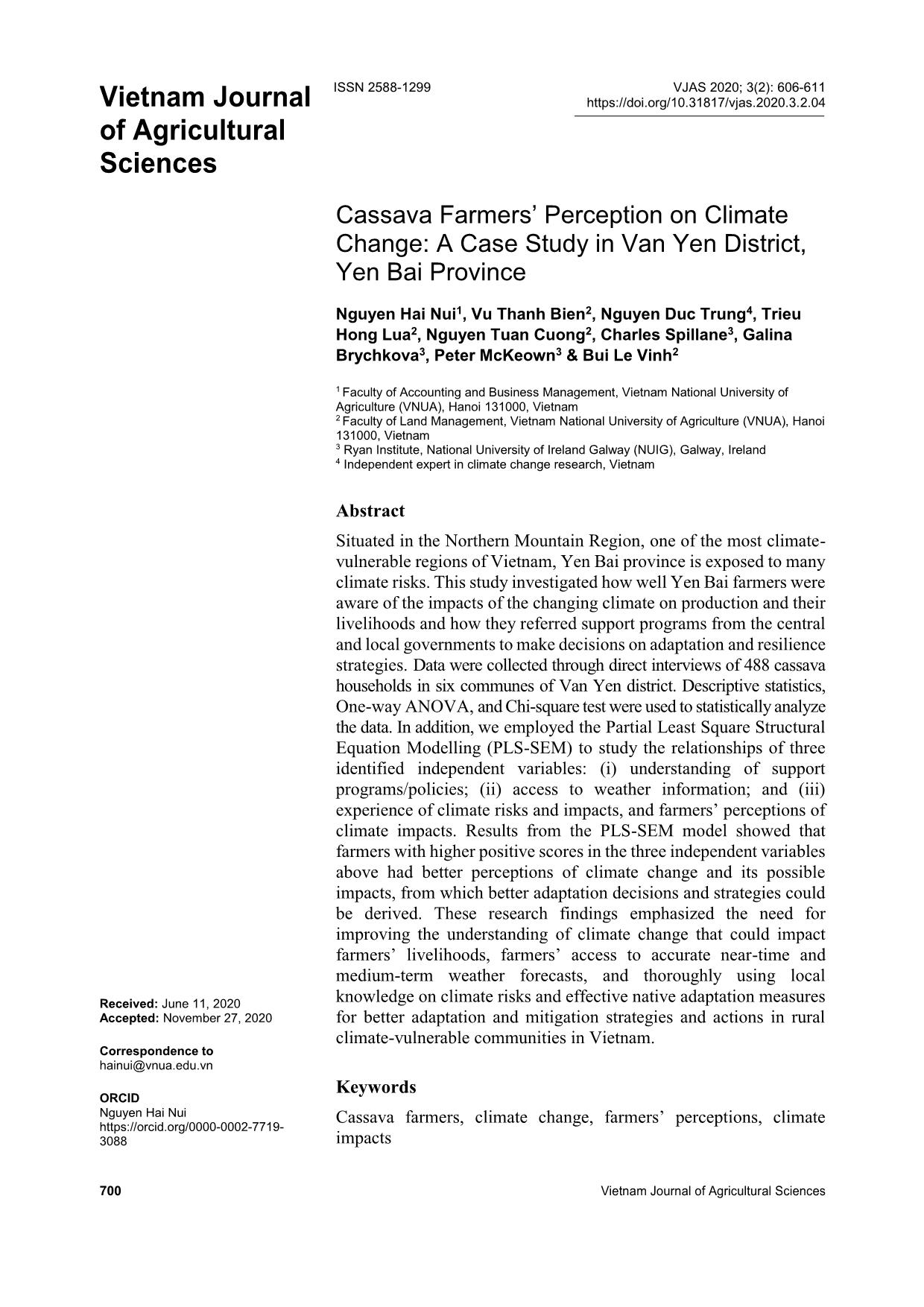
Trang 1
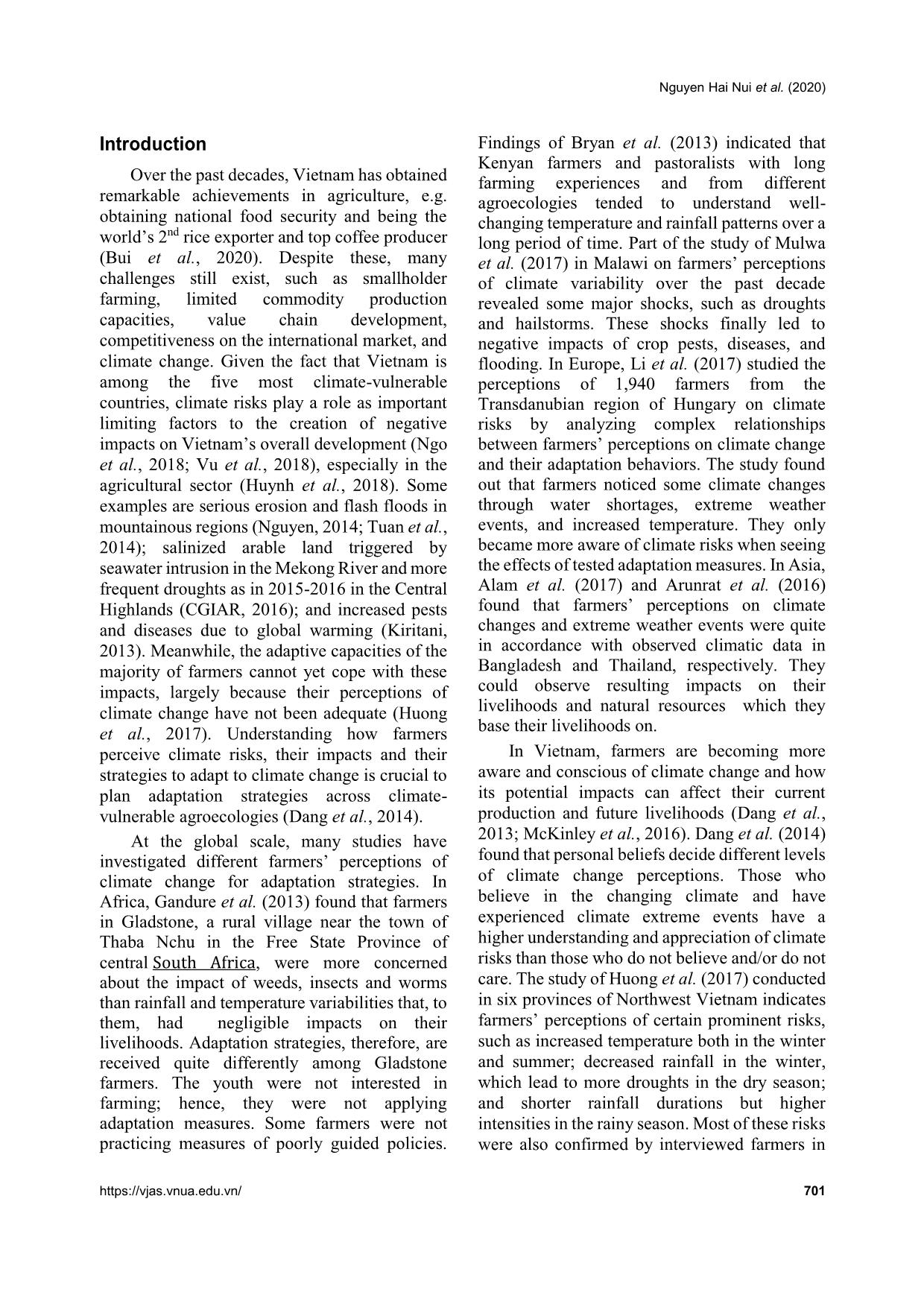
Trang 2
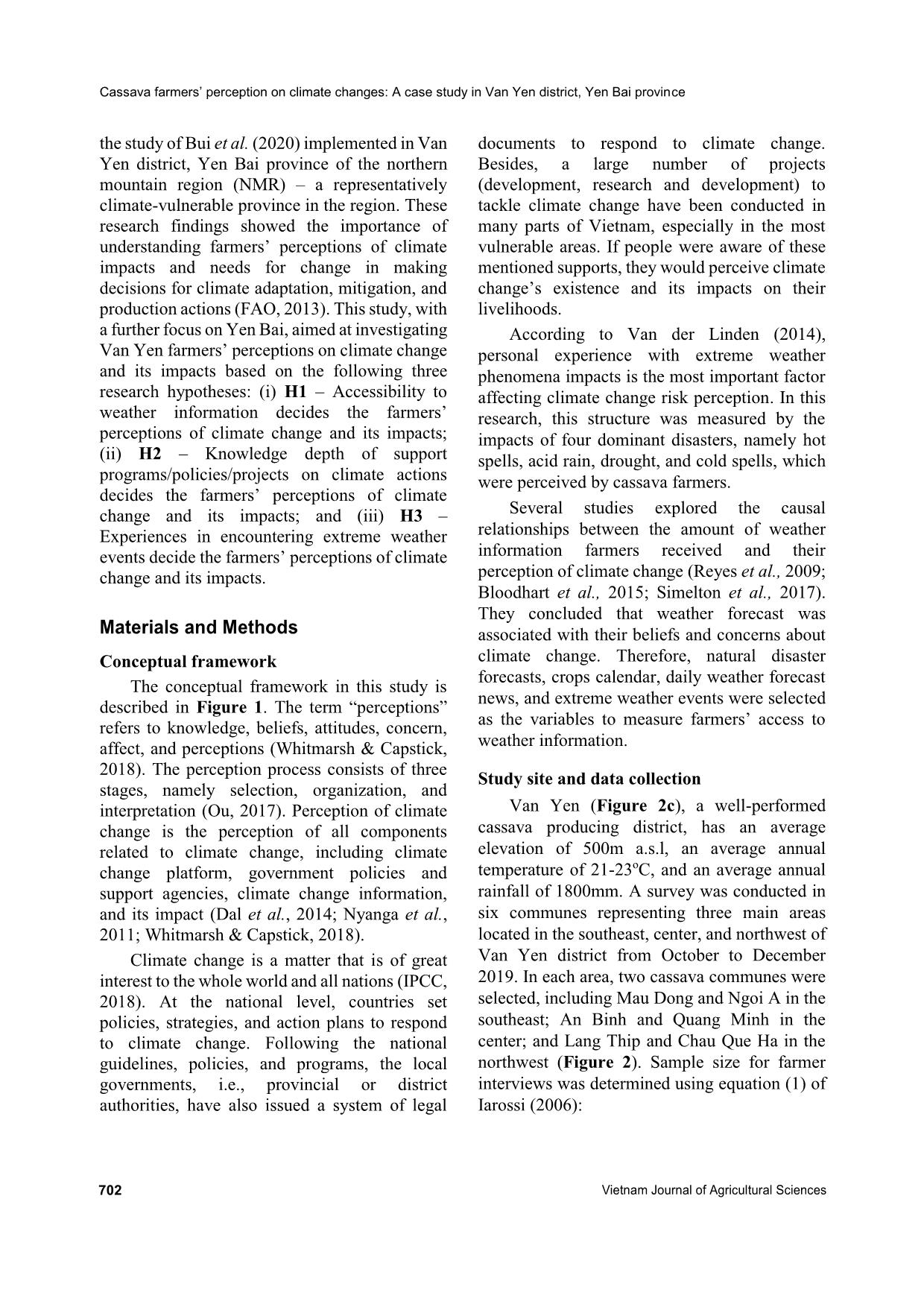
Trang 3
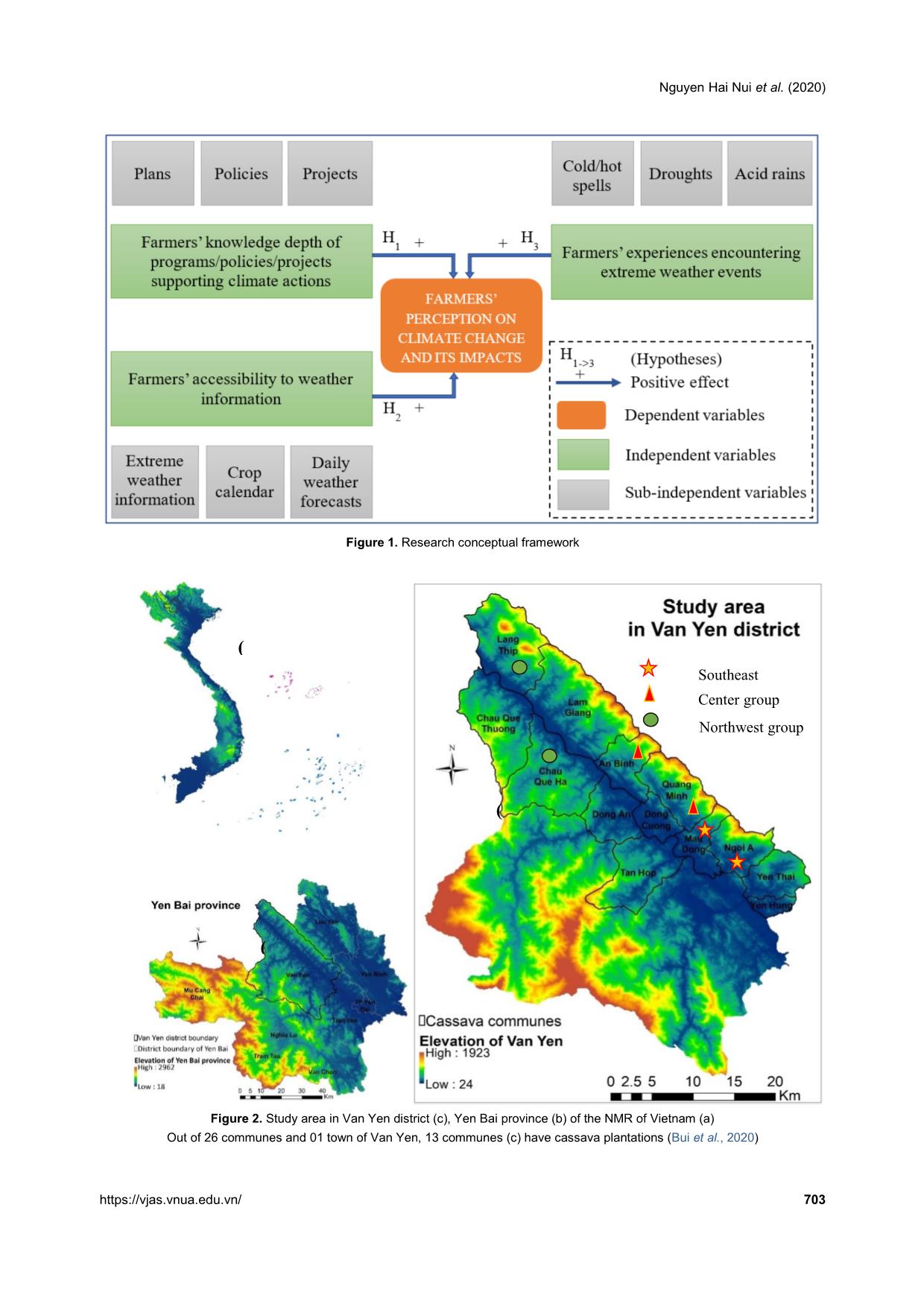
Trang 4
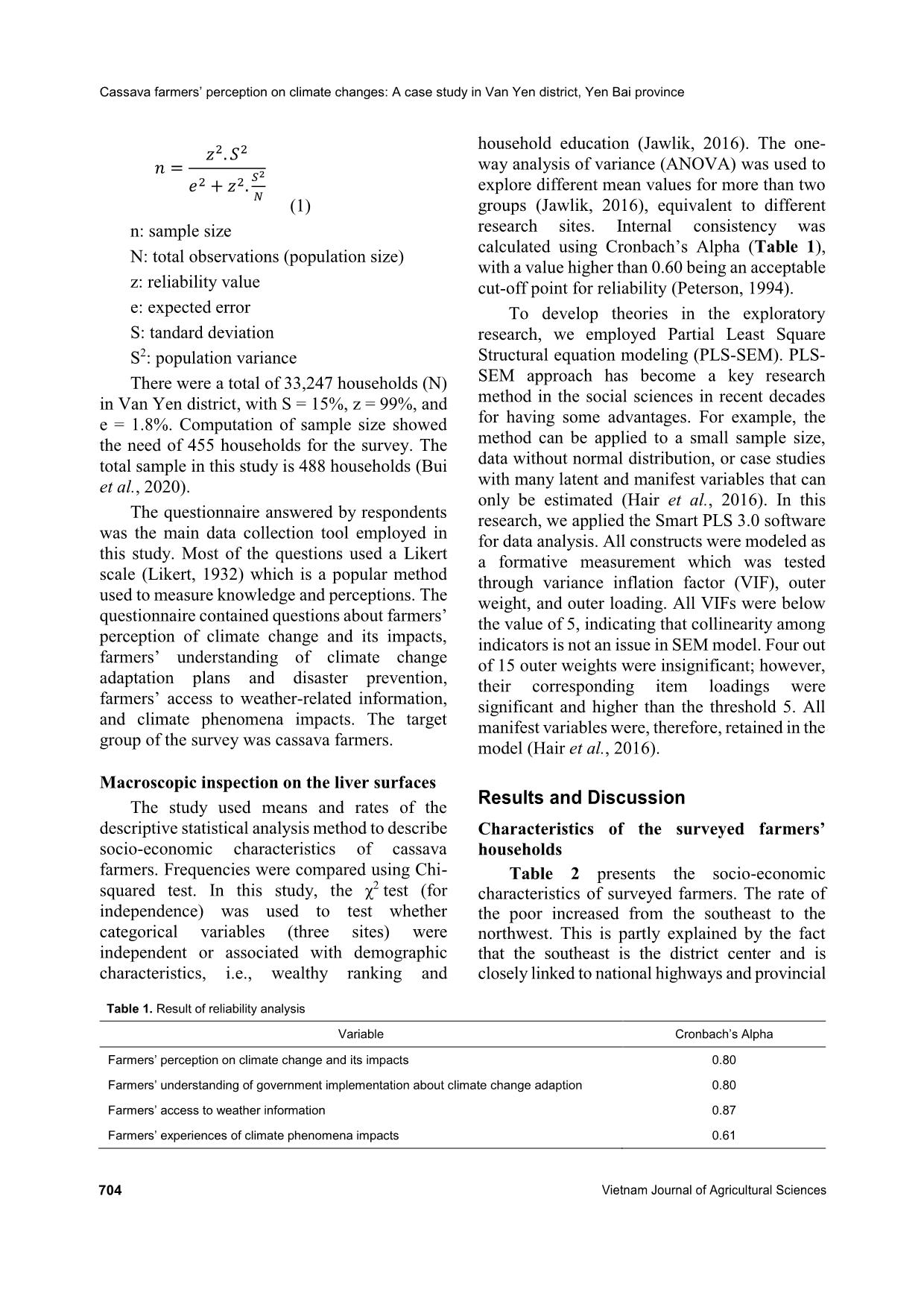
Trang 5
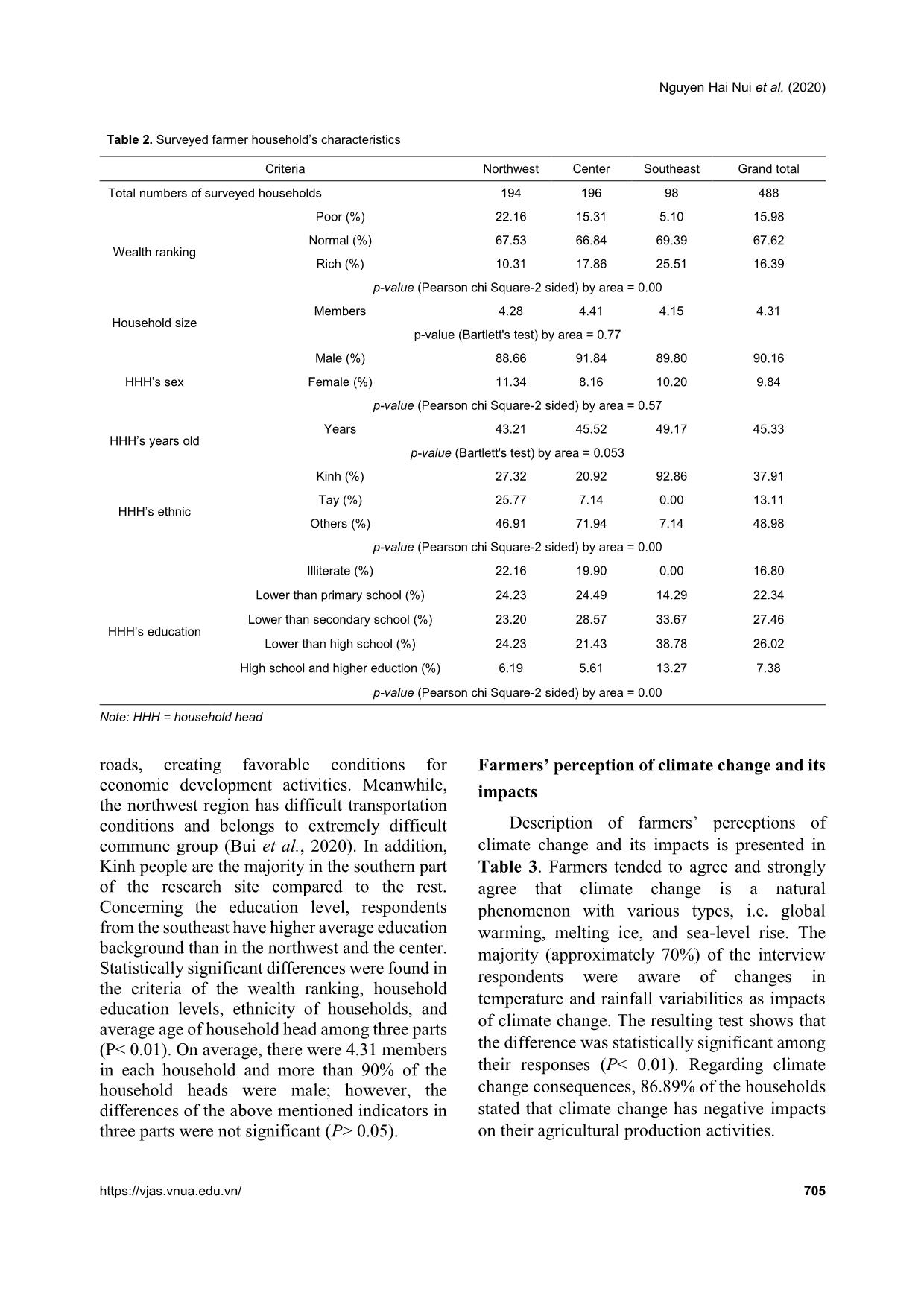
Trang 6
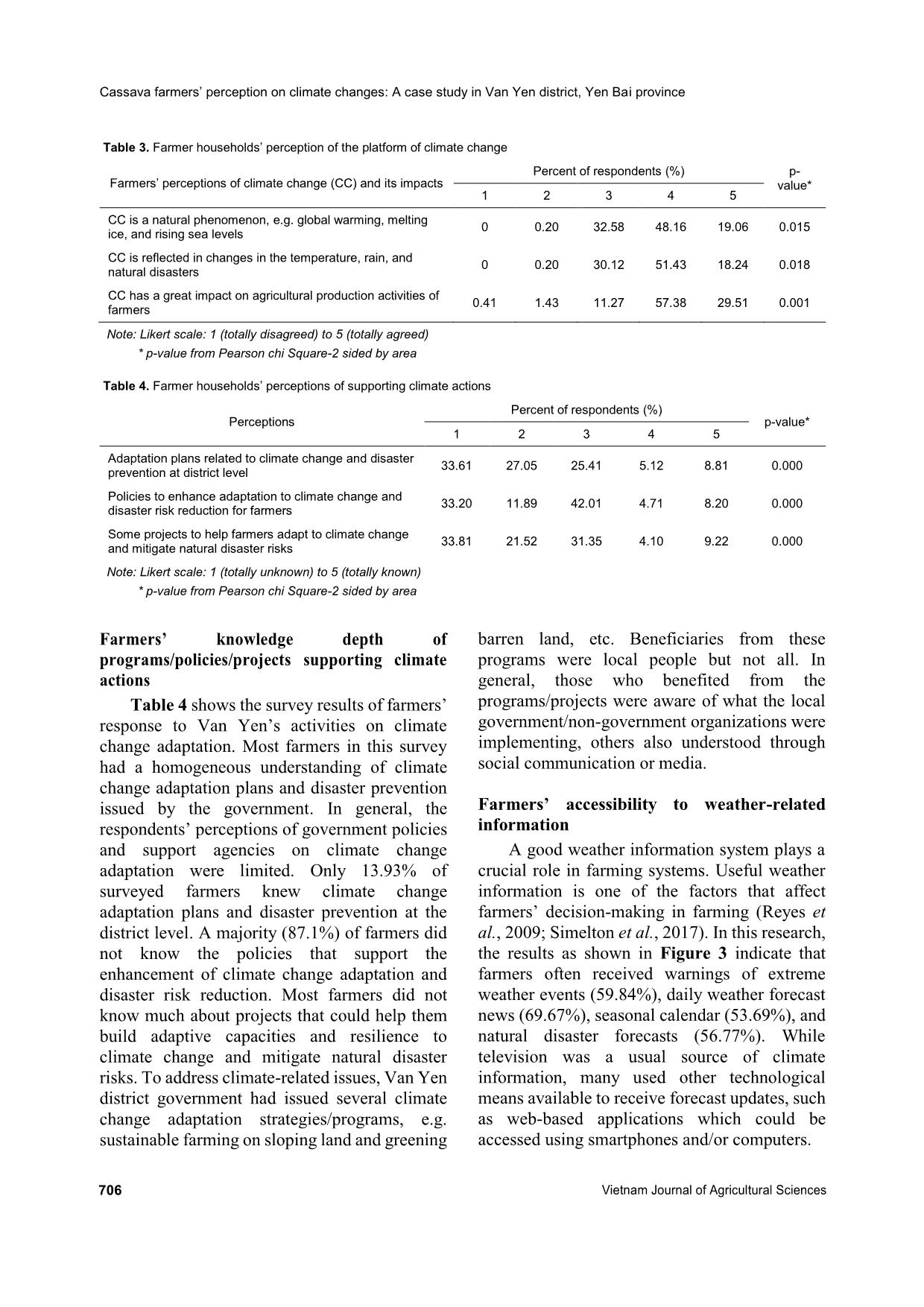
Trang 7
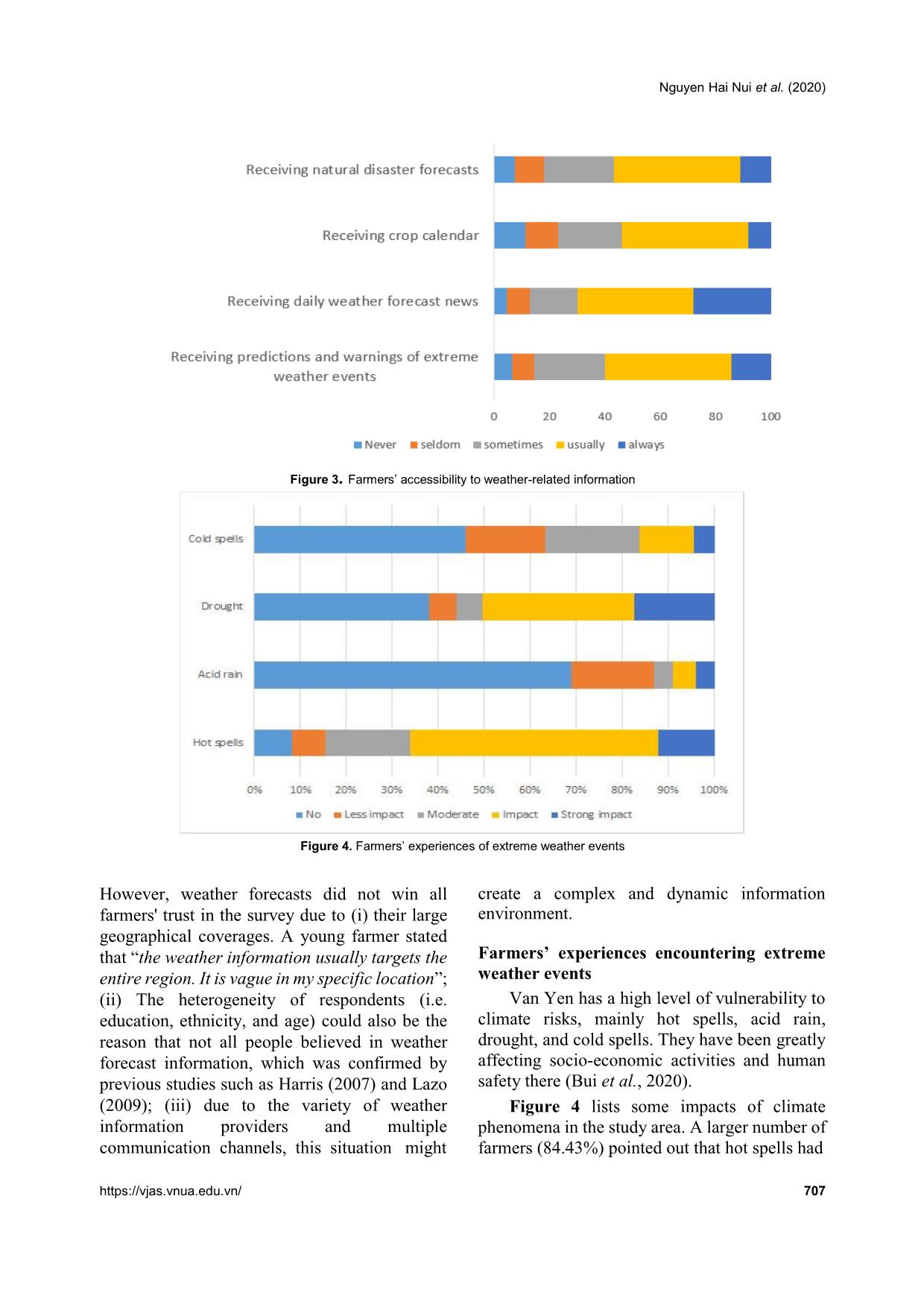
Trang 8
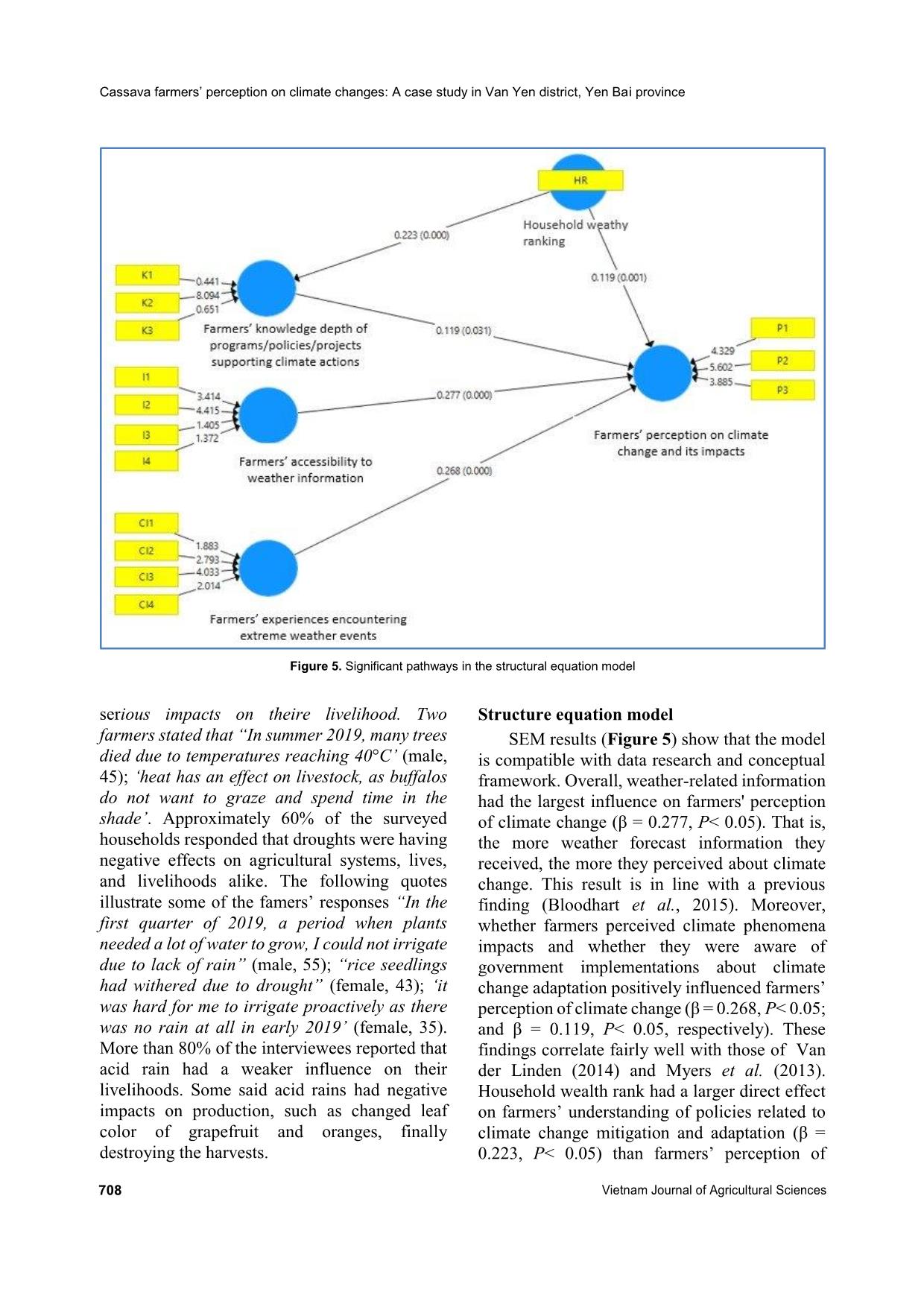
Trang 9
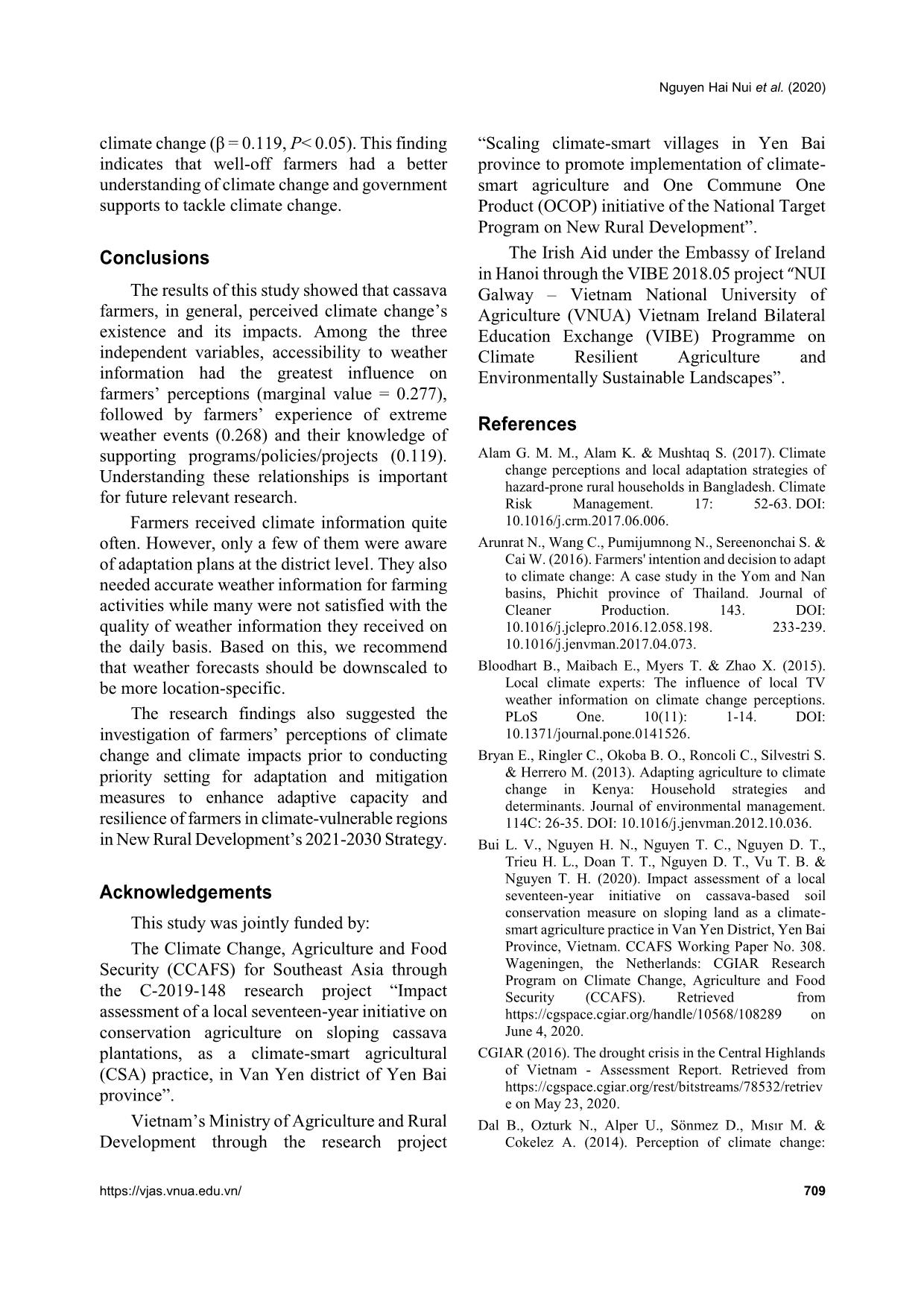
Trang 10
Tải về để xem bản đầy đủ
Tóm tắt nội dung tài liệu: Cassava farmers’ perception on climate change: A case study in Van Yen district, Yen Bai province
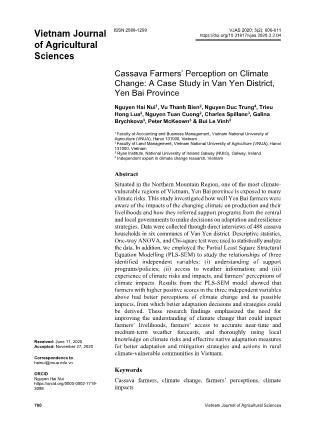
ther information providers and multiple communication channels, this situation might create a complex and dynamic information environment. Farmers’ experiences encountering extreme weather events Van Yen has a high level of vulnerability to climate risks, mainly hot spells, acid rain, drought, and cold spells. They have been greatly affecting socio-economic activities and human safety there (Bui et al., 2020). Figure 4 lists some impacts of climate phenomena in the study area. A larger number of farmers (84.43%) pointed out that hot spells had Cassava farmers’ perception on climate changes: A case study in Van Yen district, Yen Bai province 708 Vietnam Journal of Agricultural Sciences Figure 5. Significant pathways in the structural equation model serious impacts on theire livelihood. Two farmers stated that “In summer 2019, many trees died due to temperatures reaching 40°C’ (male, 45); ‘heat has an effect on livestock, as buffalos do not want to graze and spend time in the shade’. Approximately 60% of the surveyed households responded that droughts were having negative effects on agricultural systems, lives, and livelihoods alike. The following quotes illustrate some of the famers’ responses “In the first quarter of 2019, a period when plants needed a lot of water to grow, I could not irrigate due to lack of rain” (male, 55); “rice seedlings had withered due to drought” (female, 43); ‘it was hard for me to irrigate proactively as there was no rain at all in early 2019’ (female, 35). More than 80% of the interviewees reported that acid rain had a weaker influence on their livelihoods. Some said acid rains had negative impacts on production, such as changed leaf color of grapefruit and oranges, finally destroying the harvests. Structure equation model SEM results (Figure 5) show that the model is compatible with data research and conceptual framework. Overall, weather-related information had the largest influence on farmers' perception of climate change (β = 0.277, P< 0.05). That is, the more weather forecast information they received, the more they perceived about climate change. This result is in line with a previous finding (Bloodhart et al., 2015). Moreover, whether farmers perceived climate phenomena impacts and whether they were aware of government implementations about climate change adaptation positively influenced farmers’ perception of climate change (β = 0.268, P< 0.05; and β = 0.119, P< 0.05, respectively). These findings correlate fairly well with those of Van der Linden (2014) and Myers et al. (2013). Household wealth rank had a larger direct effect on farmers’ understanding of policies related to climate change mitigation and adaptation (β = 0.223, P< 0.05) than farmers’ perception of Nguyen Hai Nui et al. (2020) https://vjas.vnua.edu.vn/ 709 climate change (β = 0.119, P< 0.05). This finding indicates that well-off farmers had a better understanding of climate change and government supports to tackle climate change. Conclusions The results of this study showed that cassava farmers, in general, perceived climate change’s existence and its impacts. Among the three independent variables, accessibility to weather information had the greatest influence on farmers’ perceptions (marginal value = 0.277), followed by farmers’ experience of extreme weather events (0.268) and their knowledge of supporting programs/policies/projects (0.119). Understanding these relationships is important for future relevant research. Farmers received climate information quite often. However, only a few of them were aware of adaptation plans at the district level. They also needed accurate weather information for farming activities while many were not satisfied with the quality of weather information they received on the daily basis. Based on this, we recommend that weather forecasts should be downscaled to be more location-specific. The research findings also suggested the investigation of farmers’ perceptions of climate change and climate impacts prior to conducting priority setting for adaptation and mitigation measures to enhance adaptive capacity and resilience of farmers in climate-vulnerable regions in New Rural Development’s 2021-2030 Strategy. Acknowledgements This study was jointly funded by: The Climate Change, Agriculture and Food Security (CCAFS) for Southeast Asia through the C-2019-148 research project “Impact assessment of a local seventeen-year initiative on conservation agriculture on sloping cassava plantations, as a climate-smart agricultural (CSA) practice, in Van Yen district of Yen Bai province”. Vietnam’s Ministry of Agriculture and Rural Development through the research project “Scaling climate-smart villages in Yen Bai province to promote implementation of climate- smart agriculture and One Commune One Product (OCOP) initiative of the National Target Program on New Rural Development”. The Irish Aid under the Embassy of Ireland in Hanoi through the VIBE 2018.05 project “NUI Galway – Vietnam National University of Agriculture (VNUA) Vietnam Ireland Bilateral Education Exchange (VIBE) Programme on Climate Resilient Agriculture and Environmentally Sustainable Landscapes”. References Alam G. M. M., Alam K. & Mushtaq S. (2017). Climate change perceptions and local adaptation strategies of hazard-prone rural households in Bangladesh. Climate Risk Management. 17: 52-63. DOI: 10.1016/j.crm.2017.06.006. Arunrat N., Wang C., Pumijumnong N., Sereenonchai S. & Cai W. (2016). Farmers' intention and decision to adapt to climate change: A case study in the Yom and Nan basins, Phichit province of Thailand. Journal of Cleaner Production. 143. DOI: 10.1016/j.jclepro.2016.12.058.198. 233-239. 10.1016/j.jenvman.2017.04.073. Bloodhart B., Maibach E., Myers T. & Zhao X. (2015). Local climate experts: The influence of local TV weather information on climate change perceptions. PLoS One. 10(11): 1-14. DOI: 10.1371/journal.pone.0141526. Bryan E., Ringler C., Okoba B. O., Roncoli C., Silvestri S. & Herrero M. (2013). Adapting agriculture to climate change in Kenya: Household strategies and determinants. Journal of environmental management. 114C: 26-35. DOI: 10.1016/j.jenvman.2012.10.036. Bui L. V., Nguyen H. N., Nguyen T. C., Nguyen D. T., Trieu H. L., Doan T. T., Nguyen D. T., Vu T. B. & Nguyen T. H. (2020). Impact assessment of a local seventeen-year initiative on cassava-based soil conservation measure on sloping land as a climate- smart agriculture practice in Van Yen District, Yen Bai Province, Vietnam. CCAFS Working Paper No. 308. Wageningen, the Netherlands: CGIAR Research Program on Climate Change, Agriculture and Food Security (CCAFS). Retrieved from https://cgspace.cgiar.org/handle/10568/108289 on June 4, 2020. CGIAR (2016). The drought crisis in the Central Highlands of Vietnam - Assessment Report. Retrieved from https://cgspace.cgiar.org/rest/bitstreams/78532/retriev e on May 23, 2020. Dal B., Ozturk N., Alper U., Sönmez D., Mısır M. & Cokelez A. (2014). Perception of climate change: Cassava farmers’ perception on climate changes: A case study in Van Yen district, Yen Bai province 710 Vietnam Journal of Agricultural Sciences Reasons, consequences, and willingness to act. How aware are they? International Journal for Cross- Disciplinary Subjects in Education. 4: 1930-1937. DOI: 10.20533/ijcdse.2042.6364.2014.0268. Dang L. H., Li E., Bruwer J. & Nuberg I. (2013). Farmers’ perceptions of climate variability and barriers to adaptation: lessons learned from an exploratory study in Vietnam. Mitigation and Adaptation Strategies for Global Change. DOI: 10.1007/s11027-012-9447-6. Dang L. H., Li E., Nuberg I. & Bruwer J. (2014). Farmers’ Perceived Risks of Climate Change and Influencing Factors: A Study in the Mekong Delta, Vietnam. Environmental Management. 54(2): 331-345. DOI: 10.1007/s00267-014-0299-6. FAO (2013). Climate-smart agriculture sourcebook. Retrieved from on May 17, 2020. Rome. Gandure S., Walker S. & Botha J. (2013). Farmers' perceptions of adaptation to climate change and water stress in a South African rural community. Environmental Development. 5: 39-53. DOI: 10.1016/j.envdev.2012.11.004. Hair Jr. J. F., Hult G. T. M., Ringle C. & Sarstedt M. (2016). A primer on partial least squares structural equation modeling (PLS-SEM). Sage publications. Harris P. (2007). Local television news is the place for weather forecasts for a plurality of Americans. The Harris Poll #118, issued on November 28, 2007. Retrieved from https://theharrispoll.com/local- television-news-is-the-place-for-weather-forecasts- for-a-plurality-of-americans-11-28-2007/ on December 21, 2020. Huong N. T. L., Shun Bo Y. & Fahad S. (2017). Farmers’ perception, awareness and adaptation to climate change: evidence from northwest Vietnam. International Journal of Climate Change Strategies and Management. 9(4): 555-576. DOI: 10.1108/IJCCSM-02-2017-0032. Huynh Thi Lan Huong, Nguyen Thi Lieu, Tran Van Tra, Tran Thanh Thuy, Vu Duc Dang Quang, Tran Tien Dung. (2018). Impacts of climate changes to Vietnam’s sustainable development. Journal for Climate Change Sciences. Vietnam Institute of Meteorology, Hydrology and Climate Change. 6: 23- 33 (in Vietnamese). Iarossi G. (2006). The Power of Survey Design : A User's Guide for Managing Surveys, Interpreting Results, and Influencing Respondents. Washington, DC: World Bank. © World Bank. Retrieved from https://openknowledge.worldbank.org/handle/10986/6 975 on October 22, 2020. License: CC BY 3.0 IGO. IPCC (2018). Global Warming of 1.5°C. An IPCC Special Report on the impacts of global warming of 1.5°C above pre-industrial levels and related global greenhouse gas emission pathways, in the context of strengthening the global response to the threat of climate change, sustainable development, and efforts to eradicate poverty [Masson-Delmotte, V., P. Zhai, H.-O. Pörtner, D. Roberts, J. Skea, P.R. Shukla, A. Pirani, W. Moufouma-Okia, C. Péan, R. Pidcock, S. Connors, J.B.R. Matthews, Y. Chen, X. Zhou, M.I. Gomis, E. Lonnoy, T. Maycock, M. Tignor, and T. Waterfield (Eds.)]. In Press. Jawlik A. A. (2016). Statistics from a to z: Confusing concepts clarified. John Wiley & Sons. John Wiley & Sons.Kiritani K. (2013). Different effects of climate change on the population dynamics of insects. Applied Entomology Zoology. 48: 97-104. DOI: 10.1007/s13355-012-0158-y. Lazo J. K., Morss R. E. & Demuth J. L. (2009). 300 billion served: Sources, perceptions, uses, and values of weather forecasts. Bulletin of the American Meteorological Society. 90(6): 785-798. Li S., Juhász-Horváth L., Harrison P., Pinter L. & Rounsevell M. (2017). Relating farmer's perceptions of climate change risk to adaptation behaviour in Hungary. Journal of Environmental Management. 185: 21-30. DOI: 10.1016/j.jenvman.2016.10.051. Likert R. (1932). A technique for the measurement of attitudes. Archives of Psychology. 140: 5-55. McKinley J., Adaro C., Pede V. O., Rutsaert P., Setiyono T., Cong Thang T., Lien Huong D., Trung Kien N., Balangue Z., Bandyopadhyay S., Sheinkman M. & Wassman R. (2016). Gender Differences in Climate Change Perception and Adaptation Strategies: The Case of Three Provinces in Vietnam’s Mekong River Delta, CCAFS Report. CGIAR Research Program on Climate Change, Agriculture and Food Security (CCAFS). Copenhagen, Denmark. Retrieved from www.ccafs.cgiar.org on May 20, 2020. Mulwa C., Marenya P., Rahut D. B. & Berresaw M. (2017). Response to Climate Risks among Smallholder Farmers in Malawi: A Multivariate Probit Assessment of the Role of Information, Household Demographics, and Farm Characteristics. Climate Risk Management. 16: 208-221. DOI: 16. 10.1016/j.crm.2017.01.002. Myers T. A., Maibach E. W., Roser-Renouf C., Akerlof K. & Leiserowitz A. A. (2013). The relationship between personal experience and belief in the reality of global warming. Nature Climate Change. 3(4): 343-347. Ngo Thi Van Anh, Le Van Quy, Le Van Linh, Tran Thi Dieu Hang. (2018). Review and propose to improve the monitoring system acid deposition in Vietnam. Journal for Climate Change Sciences. Vietnam Institute of Meteorology, Hydrology and Climate Change. (8): 1-11 (in Vietnamese). Nguyen V. K. (2014). Investigation of roles of factors that are related to soil erosion in Vietnam. Journal for Forestry Sciences. 1/2014 (3145 - 3153). Vietnamese Academy of Forestry Sciences – VAFS. ISSN: 1859-0373. Nyanga P., Johnsen F., Aune J. & Kalinda, T. (2011). Smallholder Farmers' Perceptions of Climate Change and Conservation Agriculture: Evidence from Zambia. Journal of Sustainable Development. 4(4): 73-85. DOI: 10.5539/jsd.v4n4p73. Nguyen Hai Nui et al. (2020) https://vjas.vnua.edu.vn/ 711 Ou Q. (2017). A Brief Introduction to Perception. Studies in Literature and Language. 15 (4): 18-28. DOI: 10.3968/10055. Peterson R. A. (1994). A meta-analysis of Cronbach's coefficient alpha. Journal of Consumer Research. 21(2): 381-391. Reyes C. M., Domingo S. N., Mina C. D. & Gonzales K. G. (2009). Climate variability, SCF, and corn farming in Isabela, Philippines: a farm and household level analysis. Philippine Institute for Development Studies. Simelton E., Le V. H., Duong M. T. & Le D. H. (2017). Climate-induced vulnerabilities: Participatory assessment for My Loi village, Ky Son commune, Ky Anh district, Ha Tinh province. CCAFS Working Paper no. 216. Wageningen, The Netherlands: CGIAR Research Program on Climate Change, Agriculture and Food Security (CCAFS). Retrieved on May 17, 2020 from www.ccafs.cgiar.org. Tuan V. D., Hilger T., MacDonald L., Clemens G., Shiraishi E., Vien T. D., Stahr K. & Cadisch G. (2014). Mitigation potential of soil conservation in maize cropping on steep slopes. Field Crops Research. 156: 91-102. Van der Linden S. (2014). On the relationship between personal experience, affect and risk perception: The case of climate change. European Journal of Social Psychology. 44(5): 430-440. DOI: 10.1002/ejsp.2008. Vu Van Thang, Nguyen Dang Mau, Nguyen Huu Quyen, Pham Thi Hai Yen, Tran Thi Thao, Truong Thi Thanh Thuy, Tran Trung Nghia, Phung Thi My Linh. (2018). Climate assessment in 2017 in Vietnam. Journal for Climate Change Sciences. Vietnam Institute of Meteorology, Hydrology and Climate Change. 8: 13- 22 (in Vietnamese). Whitmarsh L. & Capstick S. (2018). Perceptions of climate change. In: Psychology and climate change. Academic Press: 13-33.
File đính kèm:
 cassava_farmers_perception_on_climate_change_a_case_study_in.pdf
cassava_farmers_perception_on_climate_change_a_case_study_in.pdf

